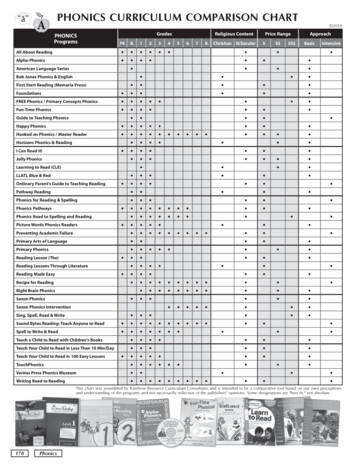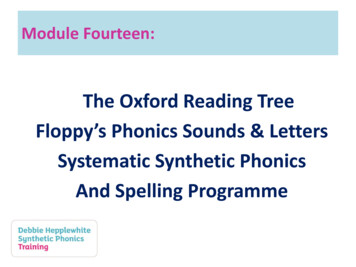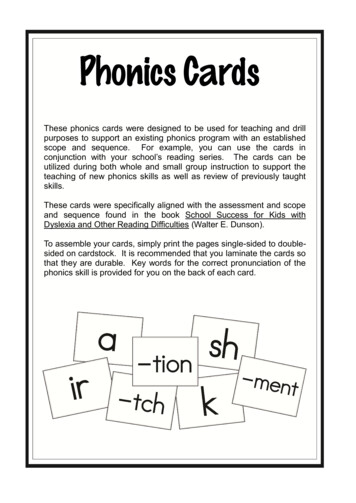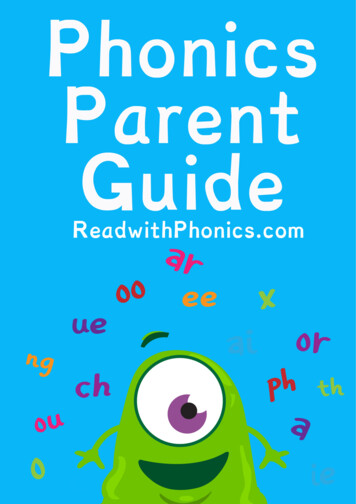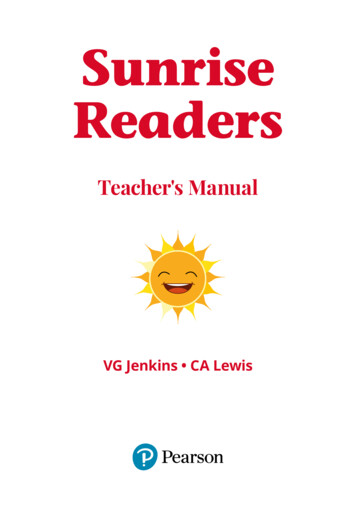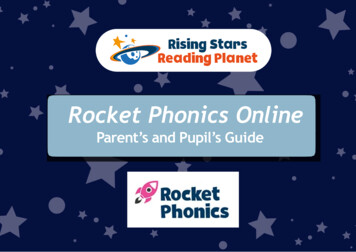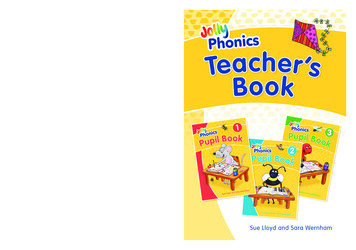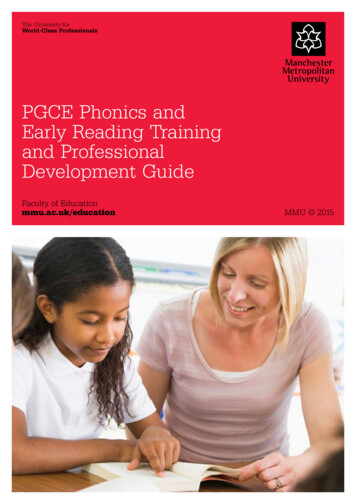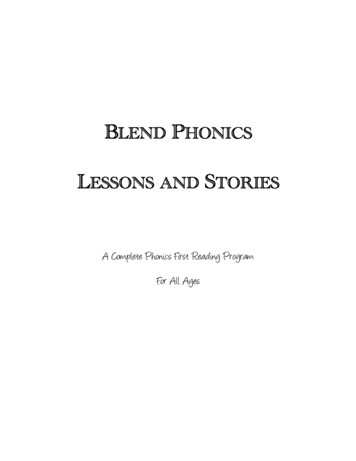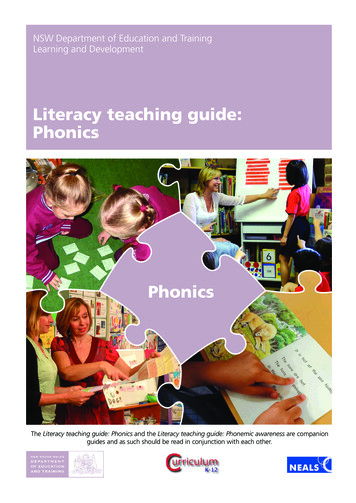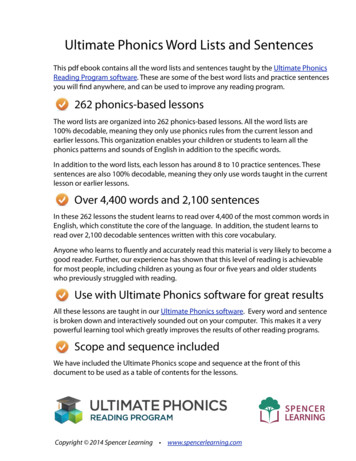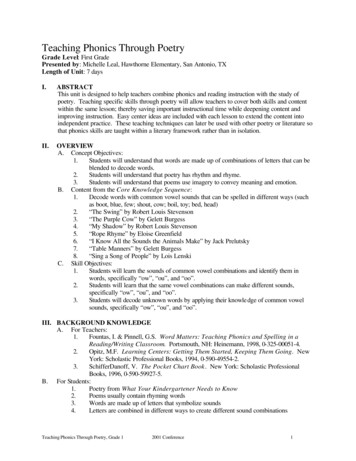
Transcription
Teaching Phonics Through PoetryGrade Level: First GradePresented by: Michelle Leal, Hawthorne Elementary, San Antonio, TXLength of Unit: 7 daysI.ABSTRACTThis unit is designed to help teachers combine phonics and reading instruction with the study ofpoetry. Teaching specific skills through poetry will allow teachers to cover both skills and contentwithin the same lesson; thereby saving important instructional time while deepening content andimproving instruction. Easy center ideas are included with each lesson to extend the content intoindependent practice. These teaching techniques can later be used with other poetry or literature sothat phonics skills are taught within a literary framework rather than in isolation.II.OVERVIEWA. Concept Objectives:1.Students will understand that words are made up of combinations of letters that can beblended to decode words.2.Students will understand that poetry has rhythm and rhyme.3.Students will understand that poems use imagery to convey meaning and emotion.B. Content from the Core Knowledge Sequence:1.Decode words with common vowel sounds that can be spelled in different ways (suchas boot, blue, few; shout, cow; boil, toy; bed, head)2.“The Swing” by Robert Louis Stevenson3.“The Purple Cow” by Gelett Burgess4.“My Shadow” by Robert Louis Stevenson5.“Rope Rhyme” by Eloise Greenfield6.“I Know All the Sounds the Animals Make” by Jack Prelutsky7.“Table Manners” by Gelett Burgess8.“Sing a Song of People” by Lois LenskiC. Skill Objectives:1.Students will learn the sounds of common vowel combinations and identify them inwords, specifically “ow”, “ou”, and “oo”.2.Students will learn that the same vowel combinations can make different sounds,specifically “ow”, “ou”, and “oo”.3.Students will decode unknown words by applying their knowle dge of common vowelsounds, specifically “ow”, “ou”, and “oo”.III. BACKGROUND KNOWLEDGEA. For Teachers:1.Fountas, I. & Pinnell, G.S. Word Matters: Teaching Phonics and Spelling in aReading/Writing Classroom. Portsmouth, NH: Heinemann, 1998, 0-325-00051-4.2.Opitz, M.F. Learning Centers: Getting Them Started, Keeping Them Going. NewYork: Scholastic Professional Books, 1994, 0-590-49554-2.3.SchifferDanoff, V. The Pocket Chart Book. New York: Scholastic ProfessionalBooks, 1996, 0-590-59927-5.B. For Students:1.Poetry from What Your Kindergartener Needs to Know2.Poems usually contain rhyming words3.Words are made up of letters that symbolize sounds4.Letters are combined in different ways to create different sound combinationsTeaching Phonics Through Poetry, Grade 12001 Conference1
IV. RESOURCESA. Hirsch, Jr. E.D. What Your First Grader Needs to Know.B. Fountas, I. & Pinnell, G.S. Word Matters: Teaching Phonics and Spelling in theReading/Writing ClassroomC. Opitz, M.F. Learning Centers: Getting Them Started, Keeping Them Going.D. Phillips, V.L. & Schlosser, K.G. Building Literacy Centers with Interactive Charts.E. SchifferDanoff, V. The Pocket Chart Book.V.LESSONSLesson One: “The Swing”A. Daily Objectives1.Concept Objectivesa. Students will understand that words are made up of combinations of letters thatcan be blended to decode words.b. Students will understand that poetry has rhythm and rhyme.c. Students will understand that poems use imagery to convey meaning and emotion.2.Lesson Contenta. “The Swing” by Robert Louis Stevenson3.Skill Objectivesa. Students will learn the sounds of common vowel combinations and identify themin words, specifically “ow”.B. Materials1.“The Swing” written on big chart paper, preferably laminated2.markers3.Poetry Journal – 8 pieces of notebook paper stapled inside a 18x12 sheet of foldedconstruction paper. One per student.4.Big chart paper modeled on Appendix A5.Sentence strips with words from poem written on them but leaving off the final rhymingword on each line. For example, “How do you like to go up in a”6.Final rhyming words written on individual sentence strips. For example, “swing.”7.Pocket chartC. Key Vocabulary1.pleasantest – agreeable or cheerful2.cattle – more than one cow3.countryside – rural district4.poem – a composition, usually metrical and rhymed, that expresses creative imagination5.rhythm – the movement or flow in which there is a recurring beat6.rhyme – words that have the same ending sound7.stanza – section of a poem8.imagery – mental images or figurative languageD. Procedures/Activities1. Explain to children that we are beginning a unit on poetry. Ask them what they knowabout poetry or what they think it is.2. Monitor the children’s responses. If they do not suggest it, remind them poetry usuallyuses rhyming words and has a rhythm to its words.3. Give examples of jump rope rhymes that have distinct rhymes and rhythm. For example:Cinderella,Dressed in yella,Went upstairs to kiss a fella,Made a mistake,Teaching Phonics Through Poetry, Grade 12001 Conference2
E.Kissed a snake,How many doctors did it take?Most children will recognize this common rhyme and will be able to hear its strongrhythmic beat.4. Read “The Swing” to the class while pointing to it on the big chart paper. Emphasize therhythm of the language and rhyming words. Also explain any unfamiliar vocabularyused in the poem at this time.5. Ask the children to close their eyes and visualize the words. Reread the poem. If there isa swing at your school, you may want to take the class out to experience the feelings ofbeing on a swing at this point in the lesson. If not, ask them to remember what it was likewhen they have been on a swing.6. Ask children to share what they saw and/or thought of while listening to the poem. Askthe children to remember what they said because they will draw a picture of it later.7. Reread the poem again, this time having children read it with you. Ask them to focus onidentifying the rhyming words. Have children call out the words they identified asrhyming. Have them come up and underline each set of words with a marker. Use adifferent color for each set of words. When finished, ask children if they can identify therhyming pattern ABAB.8. Discuss how most poetry has a rhyming pattern.9. Call attention to the last stanza. Explain how poems are broken up into sections orstanzas. Have children look at rhyming words “brown” and “down”. Slowly segment thesounds of the word and explain how letters “ow” together make a new sound. Havechildren say the words slowly with you.10. Ask children to list other words they know that have the same sound in them. Write thewords on the big chart paper modeled on Appendix A. Depending on time, you can listthe words yourself or you could do “shared” or “interactive” writing with the studentswriting the “ow” part of the word and you supplying the rest (p. 191-206 in WordMatters). If a child says a word that has an “ou” but makes the correct sound, write it inthe second column and briefly explain how different letters make the same sounds (it willbe covered more thoroughly later).11. Leave the big chart paper up on a wall so children can add other words they findthroughout the week.12. Reread the poem one more time. Have the children raise their hands when they hear thewords with the “ow” sound. Tell them they will continue practicing the sound duringtheir reading centers.Reading Center Extensions:1. Pocket Chart Center – Place the sentence strips for “The Swing” in order in a pocketchart. Place the missing rhyming words in an envelope. Using the poem on the big chartpaper as a guide, the group should fill in the rhyming words at the end of each line. If agroup is ready for a more challenging task, they could sequence the entire poem beforeadding the missing rhyming words.2. Art or Writing Center – In their poetry journal, the children should write or draw aboutwhat they imagine seeing while swinging. You could divide this into a two-day center,with the first day for illustrating and the second day for writing.Assessment/Evaluation1.Teacher will collect the poetry journals and assess how well the children understood theimagery in the poem.2.Teacher will informally assess the pocket chart to check how well the students identifyand correctly place each of the rhyming words.3.Teacher observation of student participation in class discussion.Teaching Phonics Through Poetry, Grade 12001 Conference3
Lesson Two: “The Purple Cow” by Gelett BurgessA. Daily Objectives1. Concept Objectivesa. Students will understand that words are made up of combinations of letters thatcan be blended to decode words.b. Students will understand that poetry has rhythm and rhyme.c. Students will understand that poems use imagery to convey meaning and emotion.2. Lesson Contenta. “The Purple Cow” by Gelett Burgessb. “The Swing” – review3. Skill Objectivesa. Students will learn the sounds of common vowel combinations and identify themin words, specifically “ow”.B. Materials1.“The Purple Cow” written on big chart paper, preferably laminated2.picture of a cow3.markers4.Poetry Journal5.“ow” chart from yesterday6.magnetic letters7.small magnet boards or cookie sheets8.sentence strips with words from “The Purple Cow” written on them and then cut intoindividual word cards9.pocket chartC. Key Vocabulary1.poem – a composition, usually metrical and rhymed, that expresses creative imagination2.rhythm – the movement or flow in which there is a recurring beat3.rhyme – words that have the same ending sound4.imagery – mental pictures or figurative languageD. Procedures/Activities1.Quickly review what poetry is and that poems usually have rhyme and rhythm. Askthem to explain what each term means.2.Review “The Swing” from yesterday. Draw attention to the “ow” words and emphasizethe sound it makes.3.Introduce the “Purple Cow” as a fun poem that creates a funny images in your head.Again point out that poetry often brings out some emotion in the reader or audience.Ask the children to pay close attention to the picture created in their minds from thepoem.4.Read the poem from the big chart paper. Ask the children to share the images created intheir minds with the class. Show the picture of the cow. How is that image differentthan the one created by the poem? Have them come up with other creative things thatwould be fun to see but they would not want to be.5.Reread the poem emphasizing the rhyming words. Like yesterday, have childrenidentify the rhyming words and underline them with a marker. Identify the rhymingpattern as the same one used yesterday ABAB.6.Ask children if they recognize any vowel combination from yesterday. They should find“cow” and “anyhow”. Review the sound and look at the “ow” chart from yesterday. Goover any words the children added during the previous day. Praise them for being awareof letters in the words they are reading. If they have not added many words, encouragethem to actively look for words in books, signs, and other environmental print. GiveTeaching Phonics Through Poetry, Grade 12001 Conference4
E.children a chance to look around the classroom at this time to find “ow” words. Addthem to the list if they make the appropriate sound.Reading Center Extensions:1.ABC center – Give each child in the group a set of magnet letters and a small magnetboard. Using the “ow” chart as a guide, they should spell the words on the list with themagnet letters. Make sure that they read each word after spelling it. When they finish,they should write the words on a sheet that will be collected by the teacher.2.Art – In their poetry journal, each child should draw a funny illustration that will makeothers laugh. Underneath it they should write a sentence explaining their picture.3.Pocket Chart – Because the poem is so short, students can sequence the words in theentire poem by placing the words on sentence strips in the appropriate order in a pocketchart.Assessment/Evaluation1. Teacher will collect poetry journals to assess how well students used pictures and wordsto convey emotion.2. Teacher will observe pocket chart groups to assess how well students order the words inthe poem.3. Teacher will review the list of “ow” words written by each student.Lesson Three: “My Shadow” by Robert Louis StevensonA. Daily Objectives1. Concept Objectivesa.Students will understand that words are made up of combinations of letters thatcan be blended to decode words.b.Students will understand that poetry has rhythm and rhyme.c.Students will understand that poems use imagery to convey meaning and emotion.2.Lesson Contenta. “My Shadow” by Robert Louis Stevenson3.Skill Objectivesa.Students will learn the sounds of common vowel combinations and identify them inwords, specifically “ow” and “ou”.b.Students will learn that the same vowel combinations can make different sounds,specifically, “ow” and “ou”.c.Students will decode unknown words by applying their knowledge of commonsounds, specifically the “ow” and “ou”.B. Materials1.“My Shadow” written on big chart paper, preferably laminated2.markers3.Poetry Journal4.“ow” chart based on Appendix B5.small lamp or overhead projector6.various classroom items – like a pencil , small book, scissors, blocks, or other interestingshapes7.magnet letters8.cassette tape of three poems “The Swing”, “The Purple Cow”, and “My Shadow” withwords for each9.various “ow” words written on index cards – 7 to 10C. Key Vocabulary1.poem – a composition, usually metrical and rhymed, that expresses creative imagination2.rhythm – the movement or flow in which there is recurrent beat3.rhyme – words that have the same ending soundTeaching Phonics Through Poetry, Grade 12001 Conference5
D.E.4.imagery – mental image or figurative language5.india-rubber ball – small bouncing ball made of hard rubber6.nursie – short for a nursemaid, or babysitterProcedures/Activities1.Read the poem out loud to the children. Ask for their reactions to the poem. Explainany unfamiliar vocabulary at this time.2.Reread the poem, this time strongly emphasizing the rhythm of the words. Encouragechildren to act out the movements that go with the words.3.Discuss how shadows are formed. Why does your shadow always stick with you? Canyou ever run fast enough to get away from it? Why? Then why did the shadow notappear when the boy went out before the sun rose? Children should understand thatshadows are the dark areas where your body blocks the light. Light is required to makeshadows.4.Take out the small lamp or overhead projector (a lamp works better because you can’teasily move the projector) and place it in front of you. Turn off the classroom lights andplace various classroom objects under the lamp so the children can observe the shadowsthey make. Move each object around so that children see how the shape of shadowsdepends on the position of the object relative to the source of light.5.With the class lights still off, shine the light on various students. Have them holdvarious positions to see how their shadow changes. Move the lamp to show how thesame position will look different depending on the location of the sun or other light.6.Turn the lights back on. Reread the poem, this time focusing on the rhyming words.Have students underline the rhyming words and identify the rhyming pattern. This timeit’s AABBCCDD .7.Ask children to find any words with “ow” in them. Have children come up the chart andunderline them.8.Read the words with the class. Explain how in some cases the same letters can makedifferent sounds. Before the “ow” made a sound like in brown and now it is making along /ô/ sound. Practice making the sound several times. As a class, slowly segment thewords, making the correct sound for the “ow”. Decode the words together.9.Emphasize to the class that now that they know this letter “chunk” or “group”, they canapply it to help them sound out other words. They may have to try both sounds to seewhich one would make sense with the rest of the letters in the word.10. On the board, write the following words: mow, row, down, grow, flown, stow, clown,minnow. Slowly segment the sounds for each word to model the decoding process forthe children. Show how both sounds need to be tried to determine the correct word.11. Have children come up with a list of “ow” words that make the long /ô/ sound and listthem on another chart paper modeled on Appendix B.Reading Center Extensions:1.Overhead center – Using magnet letters and the new “ow” word chart, the childrenspell the words from the list on the overhead. Explain how the letters on the wall areshadows of the letters on the projector.2.Art or Writing Center – In their poetry journals, children draw an illustration of ashadow and write a short description of what it is.3.Listening Center – Make tapes of the poems the children have learned and place themin the listening center with copies of each poem for the children to listen to and readalong with.Assessment/Evaluation1.Teacher will collect poetry journals to assess how well students completed theassignment.Teaching Phonics Through Poetry, Grade 12001 Conference6
2.3.Teacher will observe overhead center to assess how well students spelled the words fromthe list.Teacher will call children one at a time to read the “ow” words on the cards. Teachercan determine if the child is able to apply his or her new decoding skills.Lesson Four: “ Rope Rhyme” by Eloise GreenfieldA. Daily Objectives1. Concept Objectivesa.Students will understand that words are made up of combinations of lettersthat can be blended to decode words.b.Students will understand that poetry has rhythm and rhyme.c.Students will understand that poems use imagery to convey meaning andemotion.2. Lesson Contenta.“Rope Rhyme” by Eloise Greenfield3. Skill Objectivesa.Students will learn the sounds of common vowel combinations and identifythem in words, specifically “ow” and “ou”.b.Students will learn that the same vowel combinations can make differentsounds, specifically, “ow” and “ou”.c.Students will decode unknown words by applying their knowledge ofcommon sounds, specifically the “ow” and “ou”.B. Materials1. “Rope Rhyme” written on big chart paper, preferably laminated2. markers3. Poetry Journal4. jump rope5. “ow” chart based on Appendix A6. “Rope Rhyme” on cassette tape7. sentence strips with lines from the poem written on themC. Key Vocabulary1. poem – a composition, usually metric and rhyming, that expresses creativeimagination2. rhythm – the movement or flow in which there is a recurring beat3. rhyme – words that have the same ending sound4. chant – to sing or speak in a distinctive rhythmD. Procedures/Activities1. Read the poem aloud from the chart. What does it make children want to do? Tojump rope. Explain to the children how the strong beat of the poem is read in achant to accompany people while they jump rope. The strong rhythm helps themto keep the beat.2. Practice the poem several times until the children are comfortable with it. Gooutside to the playground and allow children to jump rope while saying/singing thepoem.3. Return to the classroom and reread the poem. Identify the rhyming pattern andunderline words with markers. The pattern is AABBCCDDEE.4. Now call attention to the word “now”. Which of the “ow” sounds does it use?Remind students that the same letter combinations can make more than one sound.5. Now have children look for words with “ou” in them. They should find “ground”,“sound”, and “count” (three times). Show the children the “ow” chart from theTeaching Phonics Through Poetry, Grade 12001 Conference7
E.first day and explain how the “ou” makes the same sound as “ow” in brown. Addthe three words to the second column of the chart.6. Encourage children to look for “ou” words that can be added to the chartthroughout the day.Reading Center Extensions:1. Art or Writing Center – Have children think of their own favorite jump rope rhymeand illustrate it in their poetry journals. “Cinderella”, “Chicka Chicka”, and“Mulberry Street” are some examples.2. Listening Center – Add “Rope Rhyme” to the Listening Center.3. Pocket Chart – Children use the big chart paper to place the sentence strips in theproper order.Assessment/Evaluation1. Teacher will collect poetry journals to assess how well children drew imagery frompoetry.2. Teacher will informally observe the pocket chart groups to assess how wellstudents sequence the sentences.Lesson Five: “I Know All the Sounds the Animals Make” by Jack PrelutskyA. Daily Objectives1. Concept Objectivesa.Students will understand that words are made up of combinations of letters that canbe blended to decode words.b.Students will understand that poetry has rhythm and rhyme.c.Students will understand that poems use imagery to convey meaning and emotion.2. Lesson Contenta.“I Know All the Sounds the Animals Make” by Jack Prelutsky3. Skill Objectivesa.Students will learn the sounds of common vowel combinations and identify them inwords, specifically “ou” and “oo”.b.Students will learn that the same vowel combinations can make different sounds,specifically, “ou” and “oo”.c.Students will decode unknown words by applying their knowledge of commonvowel sounds, specifically “ou” and “oo”.B. Materials1. “I Know All the Sounds the Animals Make” written on big chart paper, preferablylaminated2. markers3. poetry journal4. “ou” chart5. “oo” chart based on Appendix D6. pictures of various animals and cards with the sound they make written on them7. magnet letters8. small magnetic boards or cookie sheets9. cards with “oo” words written on themC. Key Vocabulary1.poem – a composition, usually metrical and rhymed, that expresses creative imagination2.rhythm – the movement or flow in which there is a recurring beat3.rhyme – words that have the same ending sound4.imagery – mental picture or figurative language5.marvel – something extraordinary and astonishingTeaching Phonics Through Poetry, Grade 12001 Conference8
D.E.Procedures/Activities1.Read “I Know All the Sounds the Animals Make”. Most of the children will probablylaugh. Ask them why they are laughing. Remind children again that poetry shouldbring out some emotional response. Like “The Purple Cow”, this poem takes somethingfamiliar and changes it to make people laugh.2.Reread the poem but this time ask the children to make the incorrect sounds that theanimals make in the poem. Read it again but now have the children make the correctsound the animals make. Is this as much fun? Poetry is about creating something newand creative so being silly can be fun.3.Have children create their own silly combinations of animals and mismatching sounds.4.Have students identify the rhyming words and underline them. Identify the rhymingpattern AABBCCDD.5.Ask the children to find an “ou” word like we practiced yesterday. They should identifyand underline “sounds” and “mouse”. Have them look for any “ow” words. Theyshould find and underline “know” and “cow”. Have them decode these words anddetermine which sound each vowel combination makes. Be sure to notice who isappropriately decoding the words and who is struggling.6.Introduce a new vowel combination “oo”. These letters make the sound / / like youmight say when you see something really cool. Identify the words in the poem that use“oo”. They should find “moose”, “hoot”, “moo”, and “goose”. Using their newknowledge of the sound “oo” makes, have children decode these words all together.7.Have children come up with other words that have “oo” sound and write them on the bigchart paper modeled on Appendix D.Reading Center extensions:1.Art – In their poetry journals, have children draw a picture of their favorite animal andhave it make a funny noise.2.Games – Children take the pictures of the animals and match it with its actual sound.3.ABC – Children use the words from the big chart paper to spell “oo” words with themagnetic letters. When they finish, they should write the words on a sheet that will becollected by the teacher.Assessment/Evaluation1.Teacher will collect poetry journal to assess how well directions were followed.2.Teacher will review the list of “oo” words written by each student.3.Teacher will call over students one at a time to assess if they are able to apply “oo”sound and decode new words.Lesson Six: “Table Manners” by Gelett BurgessA. Daily Objectives1. Concept Objectivesa.Students will understand that words are made up of combinations of letters that canbe blended to decode words.b.Students will understand that poetry has rhythm and rhyme.c.Students will understand that poems use imagery to convey meaning and emotion.2. Lesson Contenta.“Table Manners” by Gelett Burgess3. Skill Objectivesa.Students will learn the sounds of common vowel combinations and identify them inwords, specifically “oo”.d.Students will learn that the same vowel combinations can make different sounds,specifically, “oo”.Teaching Phonics Through Poetry, Grade 12001 Conference9
e.B.C.D.E.Students will decode unknown words by applying their knowledge of commonvowel sounds, specifically “oo”.Materials1. “Table Manners” written on big chart paper, preferably laminated2. markers3. blank big chart paper4. poetry journal5. cassette tape with “Table Manners” and words printed so that children can follow along6. cards with “ow”, “ou”, and “oo” words written on themKey Vocabulary1. poem – a composition, usually metrical and rhymed, that expresses creative imagination2. rhythm – the movement or flow in which there is a recurring beat3. rhyme – words that have the same ending sound4. imagery – mental picture or figurative language5. broth – clear, thin soupProcedures/Activities1. Read “Table Manners”. Most of the children will probably la ugh. Ask them why they arelaughing. Does this poem remind them of anyone they know?2. Reread the poem. This time ask the children to make the motions suggested by the wordsin the poem. How do they look? Would they want to eat with someone who ate like theGoops?3. This is a great time to discuss the importance of good manners while eating at the table.Have the children brainstorm a list of 3 –5 rules that everyone should follow at the dinnertable. The teacher can write these rules on a piece of big chart paper or you can do a“shared” or “interactive” writing lesson where the children help you write the rules (p.191-206 in Word Matters).4. Reread the poem and have students identify the rhyming words and underline them.Identify the rhyming pattern ABCB DEFE. This is a new rhyming pattern so be sure toexplain it carefully to the class.5. Ask the children to find an “ou” word. They should identify and underline “loud”. Havethem look for “oo” words. They should find and underline “Goops” four times. Havethem decode these words and determine which sound each vowel combination makes.6. Review the vowel combination “oo”. Look at the chart from yesterday. Can they add anynew words today?7. Write these words on the board: boot, loud, toot, crow, crown, mouth, and glow. Havechildren slowly sound out the words while applying what they have learned about vowelcombinations. Model how sometimes you have to try more than one sound for a vowelcombination to see which one is correct.Reading Center extensions:1. Art – In their poetry journals, have children draw a line down the center of the page. Onone side, draw a picture of a Goop using bad table manners. On the other side, draw apicture of themselves using good table manners. Write a short explanation of why tablemanners are important.2. Listening Center – Add “Table Manners” to the cassette with the other songs and place inthe listening center.Assessment/Evaluation1. Teacher will collect poetry journal to assess how well directions were followed.2. Teacher will call over students one at a time to assess if they are able to apply all threevowel combinations to decode new words.Teaching Phonics Through Poetry, Grade 12001 Conference10
VI. CULMINATING ACTIVITYA.This activity will use Lois Lenski’s “Sing a Song of People” to bring together all three of thevowel combinations and the rhyme and imagery studied in this unit.B.Write each stanza of the poem on a separate sheet of big chart paper and read it aloud to theclass. Have them close their eyes while you reread it. Discuss the imagery of the poem.What mental pictures did they develop while listening to the poem?C.Divide the class into five groups. Give each group one stanza of the poem. Give them a copyof Appendix J. They should identify the rhyming words and pattern and record them onAppendix J. They also write all “ow”, “ou”, and “oo” words on Appendix J.D.When they have completed Appendix J, they should begin planning actions that show theimages created in their stanza. Give each group time to practice doing the motions while onestudent reads the stanza.E.When all groups are ready, have them line up in order and go through the whole poem. Theyshould be able to move through it using the rhythm of the poem. When they have practicedenough and are ready to perform, invite other classes to see your poetry in action.VII. HANDOUTS/WORKSHEETSAppendices A-JVIII. BIBLIOGRAPHYCarle, E., ed. Animals, Animals. New York: Philomel Books, 1989, ISBN 0-399-21744-4.deRegniers, B.S., ed. Sing A Song of Popcorn: Every Child’s Book of Poems. New York: Scholastic,Inc., 1988, ISBN 0-590-40645-0.dePaola, T. Tomie DePaola’s Book of Poems. New York: Putnam Publishing Group, 1988, ISBN 0-39921540-9.Fountas, I. & Pinnell, G.S. Word Matters: Teaching Phonics and Spelling in a Reading/WritingClassroom. Portsmouth, NH: Heinemann, 1998, ISBN 0-325-00051-4.Fountas, I. & Pinnell, G.S., eds. Voices on Word Matters: Learning About Phonics and Spelling in theLiteracy Classroom. Portsmouth, NH: Heinemann, 1999, ISBN 0-325-00132-4.Hirsch, Jr. E.D. What Your First Grader Needs to Know. New York: Dell Publishing, 1998, ISBN 0-38531987-8.Larrick, N., ed. When the Dark Comes Dancing: A Bedtime Poetry Book. New York: Philomel Books,1983, ISBN 0-399-20807-0.Lobel, A., ed. The Random House Book of Mother Goose. New York: Random House, 1986, ISBN 0394-86799-8.Moore, L., ed. Go With the Poem. New York: McGraw-Hill, 1979, ISBN 0-07-042
1. “The Purple Cow” written on big chart paper, preferably laminated 2. picture of a cow 3. markers 4. Poetry Journal 5. “ow” chart from yesterday 6. magnetic letters 7. small magnet boards or cookie sheets 8. sentence strips with words from “The Purple Cow” written on the
